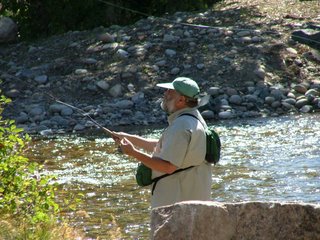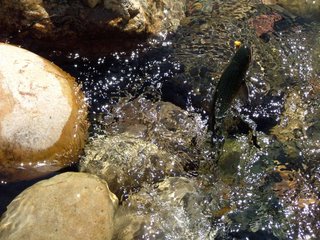Jn 21:1 Afterward Jesus appeared again to his disciples, by the Sea of Tiberias. It happened this way: 2 Simon Peter, Thomas (called Didymus), Nathanael from Cana in Galilee, the sons of Zebedee, and two other disciples were together. 3 “I’m going out to fish,” Simon Peter told them, and they said, “We’ll go with you.” So they went out and got into the boat, but that night they caught nothing.
As I mentioned a couple weeks ago, fishing and family vacations are not easy to mix together, but we decided that Friday was the day I was going to fish. Accordingly, on Wednesday I visted the Snake River Angler in Moose Wyoming (just outside the south entrance to Grand Teton National Park) and started asking for advice.
Since anglers are the bread and butter for such businesses, I bought flies as I was asking questions. The man who helped me was quite forthcoming with information, and dissuaded me from my original plan, which was fo fish Leigh Lake (north of Jenny Lake). His advice was to try the area where Cascade Creek goes into Jenny Lake, and then try Cottonwood Creek, the outlet to Jenny Lake.
All the while he was talking, he was adding flies to my pile, and I was able to stop at two dozen -- which was quite enough. My son added a t-shirt to the pile, and attempted to slip in a few other items, mostly with sharp edges. I went for the shirt, but the knives stayed at the store.
I bought a one day license for Friday, and in the morning of August 11, I got up at 6 am and walked to the boat dock for the early-bird ferry across the lake to the Cascade Canyon trailhead. Jenny Lake is a glacially-scoured basin, thus is quite deep (over 250 feet) with a steep dropoff. Where Cascade Creek comes in, it is fairly shallow, though, and I could wade it comfortably. Well, the scenery was great, and the kingfishers were out and about, but I didn't even SEE a fish let alone get one to take second look at my flies, so I took the ferry back about 9:30 am and Susan, Liam, and I piled into the car and drove down to one of the stream accesses to Cottonwood Creek.
 The stream bed of Cottonwood Creek where I fished consisted of large glacial cobblestones between 4 and 12 inches in diameter (or larger). They were slick and rolled easily (you can see where this is heading...) Susan sat on a rock near the creek while I gingerly waded out to where I could cast to likely spots.
The stream bed of Cottonwood Creek where I fished consisted of large glacial cobblestones between 4 and 12 inches in diameter (or larger). They were slick and rolled easily (you can see where this is heading...) Susan sat on a rock near the creek while I gingerly waded out to where I could cast to likely spots.I cast upstream and let the fly drift down. There were a number of belly flashes, indicating that a trout had been interested enough to take a second look, but it seemed they were not interested enough to take the offering. At least they were looking up... I tried letting the fly drift past me and downstream near the concrete supports for the one-lane bridge. This was a bit more productive, as I felt a strike. I turned so I could play the fish more comfortable, and the cobbles rolled beneath my feet. I fell and landed on my side in the creek, but I had the presence of mind to make sure I didn't fall on my rod. Susan, who had been taking lots of pictures, somehow failed to record my undignified posture for posterity.
 When I got up, I picked up the rod, and to my surprise, the trout was still on. I played it quickly, and as I took it in my hand, it squirmed and took off expeditiously for cover. It was a nice brook trout, about 8 inches.
When I got up, I picked up the rod, and to my surprise, the trout was still on. I played it quickly, and as I took it in my hand, it squirmed and took off expeditiously for cover. It was a nice brook trout, about 8 inches.I kept on fishing at that location, and played 4 more fish (or maybe the same fish 4 times), but these managed to unhook themselves. Or as fly anglers prefer to put it, these were LDRs (long distance releases). In any case, it was nice to be able to fish, and I decided to call it a good day, and we went back to camp and had lunch.
Wyoming (whose laws govern fishing in Grand Teton National Park), is trying to restore native cutthroat trout, and has a special bonus limit on brookies, and I was actually looking forward to helping in that process. My major disappointment though, was that I didn't catch any cutthroats. My fishing preferences tend toward small streams and native trout, and these are often at odds with the management practices. There are cutthroat trout, brook trout, rainbow trout, brown trout, and lake trout to be had in the various waters of Grand Teton and Yellowstone National Parks. Of all these trout, only the cutthroat are native, and when the Lewis and Clark expedition passed near this area 200 years ago, that was what they caught and ate.
Unfortunately (in my opinion), state fisheries managers had catered to the wishes of anglers to catch large fish and a lot of them, and stocking programs have imported non-native trout to fill this perceived need. It is good to see the state of Wyoming working with the National Park Service to restore the native fish, and I hope they are successful.
It was a great pleasure to fish on Friday, especially in an area of such beauty, and I hope I can fsh more. It is such a relaxing way to spend time.
All photos in this posting were taken by my wife, Susan Melia-Hancock


4 comments:
Great photos, Denis. And I bet you enjoyed the scenery as much as the fishing.
Looks like it was a great time. Welcome back.
The scenery is one of the reasons why I prefer the less-populated smaller streams. Next time I plan to bring the wading boots so I can get a little more traction on the stream bottom.
Yes, it was a great time!
I plan to do a few more posts with more images.
Post a Comment